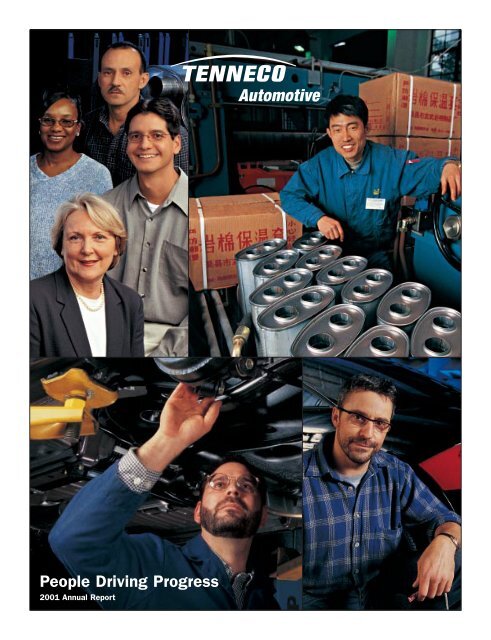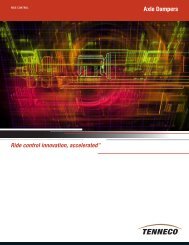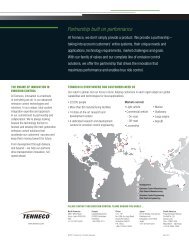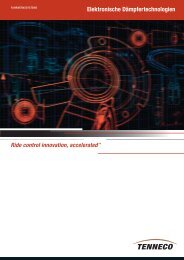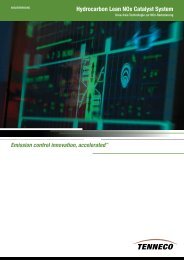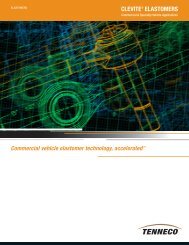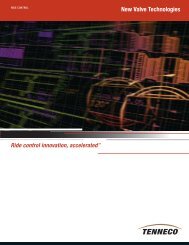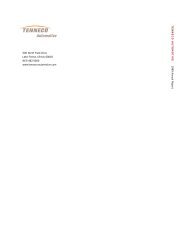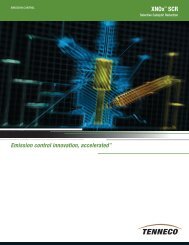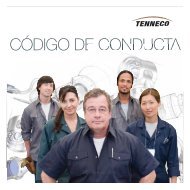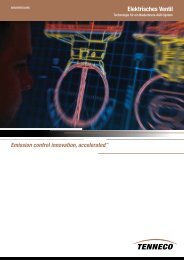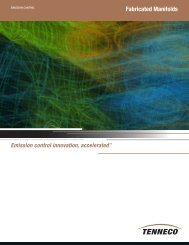2001 Annual Report - Tenneco Inc.
2001 Annual Report - Tenneco Inc.
2001 Annual Report - Tenneco Inc.
- TAGS
- annual
- tenneco
- www.tenneco.com
Create successful ePaper yourself
Turn your PDF publications into a flip-book with our unique Google optimized e-Paper software.
People Driving Progress<br />
<strong>2001</strong> <strong>Annual</strong> <strong>Report</strong>
<strong>Tenneco</strong> Automotive at a Glance<br />
Leading Brands.<br />
Corporate Profile. <strong>Tenneco</strong><br />
Automotive is one of the world’s<br />
largest designers, manufacturers<br />
and marketers of emission<br />
control and ride control products<br />
and systems for the automotive<br />
original equipment market and<br />
aftermarket. The company<br />
became an independent corporation<br />
in 1999, allowing singular<br />
focus on strategies to maximize<br />
global results.<br />
<strong>Tenneco</strong> Automotive markets<br />
its products principally under the<br />
Monroe®, Walker®, Gillet and<br />
Clevite brand names. Leading<br />
manufacturers worldwide use<br />
our products in their vehicles,<br />
attracted principally by our groundbreaking<br />
advanced technologies.<br />
We are one of the top suppliers<br />
to the automotive aftermarket,<br />
offering exceptionally strong brand<br />
recognition among consumers<br />
and trade personnel.<br />
<strong>Tenneco</strong> Automotive employs<br />
21,600 people worldwide.<br />
Strategic Balance.<br />
The company is well<br />
balanced in its business,<br />
product and<br />
geographical mix.<br />
’01 OE/AM<br />
Revenue Balance<br />
(in percent)<br />
Original Equipment<br />
Market 72%<br />
Automotive<br />
Aftermarket 28%<br />
Our Mission. <strong>Tenneco</strong> Automotive’s<br />
mission is to delight our customers<br />
as the number-one technologydriven,<br />
global manufacturer and<br />
marketer of value-differentiated<br />
ride control, emission control and<br />
elastomer products and systems.<br />
We will strengthen our leading<br />
position through a shared-value<br />
culture of employee involvement,<br />
where an intense focus on continued<br />
improvement delivers<br />
shareholder value in everything<br />
we do.<br />
’01 Product<br />
Balance<br />
(in percent)<br />
Emission<br />
Control 65%<br />
Ride Control 35%<br />
Our Vision:<br />
’01 Geographic<br />
Revenue Balance<br />
(in percent)<br />
North America 53%<br />
Europe 38%<br />
International<br />
(South America<br />
and Asia) 6%<br />
Australia 3%<br />
Pioneering global<br />
ideas for cleaner,<br />
quieter and safer<br />
transportation.
Financial Highlights<br />
(dollars in millions except per share amounts) <strong>2001</strong> 2000 1999<br />
Sales 1 $3,364 $3,528 $3,260<br />
Earnings before interest, taxes,<br />
depreciation and amortization 1 $÷«300 $÷«336 $÷«374<br />
Earnings before interest and taxes 1 $÷«147 $÷«185 $÷«230<br />
<strong>Inc</strong>ome from continuing operations 1 $÷««(18) $÷«÷÷4 $÷«÷24<br />
Earnings per share, diluted $«(0.48) $÷««.10 $÷««.74<br />
Capital expenditures $÷«127 $÷«146 $÷«154<br />
Depreciation and amortization $÷«153 $÷«151 $÷«144<br />
Average diluted shares outstanding 38,001,248 34,906,825 33,656,063<br />
Total debt $1,515 $1,527 $1,634<br />
Cash Flow 2<br />
(dollars in millions)<br />
124<br />
’98<br />
169<br />
281<br />
209<br />
’99 ’00 ’01<br />
SGA&E Expense 3<br />
(percentage of sales)<br />
14.2<br />
’98<br />
14.5<br />
’99 ’00 ’01<br />
1 Revenues for 2000 and 1999 have been reduced by $21 million and $19 million, respectively, to reflect the reclassification of certain sales incentives that<br />
were previously shown in selling, general and administrative expense. The information presented for <strong>2001</strong> is before restructuring and other charges, an environmental<br />
charge, costs associated with the amendment of certain terms of our senior credit facility and a tax charge, which combined reduced EBIT by $55 million,<br />
net income by $112 million and earnings per share by $2.95. The information presented for 2000 is before restructuring and other charges, a stock option<br />
buyback and a reversal of a reserve, which combined reduced EBIT by $65 million, net income by $45 million and earnings per share by $1.28. The information<br />
presented for 1999 is before a charge for restructuring and transaction and other expenses and also includes pro forma adjustments to recognize incremental<br />
stand-alone expenses equal to those incurred in 2000 and to adjust the 1999 capital structure to be consistent with 2000. Combined, these items reduced<br />
1999 EBIT by $82 million, net income by $87 million and earnings per share by $2.61. Additional information about these items can be found in Selected<br />
Financial Data and Management’s Discussion and Analysis in our <strong>Annual</strong> <strong>Report</strong> on Form 10-K for the year ended December 31, <strong>2001</strong>.<br />
2 Before financing activities, interest and taxes.<br />
3 Before restructuring and other charges, transaction costs, stock option buy back and senior credit facility amendment costs, which increased SGA&E by $15,<br />
$37, $80 and $53 million in <strong>2001</strong>, 2000, 1999 and 1998, respectively. Results for 1998 and 1999 have been adjusted to reflect stand-alone costs at the<br />
same level as 2000.<br />
4 Working capital includes accounts receivable and the balance of accounts receivable securitization, inventory, prepayments and other current assets, accounts<br />
payable, accrued liabilities and other current liabilities.<br />
13.0<br />
12.0<br />
Working Capital 4<br />
(percentage of sales)<br />
18.5<br />
’98<br />
15.8<br />
13.3<br />
9.2<br />
’99 ’00 ’01<br />
<strong>Tenneco</strong> Automotive <strong>Inc</strong>. 1
2<br />
To Our Shareholders<br />
I n just our second year as a stand-alone<br />
company, <strong>Tenneco</strong> Automotive made<br />
significant progress executing strategies<br />
for reducing debt and strengthening customer<br />
relationships. We concentrated on improving internal<br />
factors that we could control to help offset the challenging<br />
external operating environment. And, although<br />
our sales and earnings results were undercut by the<br />
weak automotive market and tough global economies<br />
in <strong>2001</strong>, our strategies – driven by an outstanding<br />
employee effort worldwide – yielded notable results.<br />
We reduced our net debt (total book value of debt minus<br />
cash) by $30 million and gained more than 55 new<br />
business awards from customers around the world.<br />
For the year, SGA&E expenses as a percent of sales,<br />
before restructuring and other charges, fell 1 percentage<br />
point, and working capital as a percent of sales,<br />
before factoring, declined more than 4 percentage<br />
points, evidence of our cost cutting and cash management<br />
success.<br />
Specifically, year-over-year improvement in these<br />
key metrics resulted from better operating efficiency,<br />
We will continue to leverage<br />
our advanced technology, global<br />
reach and brand strength –<br />
competitive distinctions that<br />
set us apart as a leader in ride<br />
and emission control systems.<br />
<strong>Tenneco</strong> Automotive <strong>Inc</strong>.<br />
controlled spending, reduced inventory levels and<br />
lower receivables. We achieved:<br />
• $71 million in annualized savings from<br />
restructuring activities;<br />
• $19 million in Six Sigma cost savings,<br />
a quality improvement initiative;<br />
• $19 million reduction in capital<br />
expenditures;<br />
• $92 million reduction in receivables<br />
balances; and<br />
• $96 million reduction in inventories.<br />
These efforts generated financial results that enabled<br />
us to exceed the debt covenant requirements of our<br />
bank lenders. They also positioned us better than many<br />
of our peers on year-over-year key performance metrics.<br />
A major driver of this progress was employing EVA®<br />
(Economic Value Added) 1 techniques to generate cash<br />
and target the best return on capital. And, by linking<br />
EVA improvement to compensation, we ensured that<br />
employees had a stake in enhancing our business.<br />
People Driving Progress. Our progress last year was<br />
achieved through the daily effort and initiative of our<br />
employees around the globe. I’m proud of how we’ve<br />
come together as a team since we began operating as<br />
a stand-alone company. We are unified in our goals<br />
and in the direction we’re taking to meet those goals.<br />
Employees at <strong>Tenneco</strong> Automotive have been working<br />
in cross-functional, cross-divisional teams, planning<br />
and executing strategies to drive improved results. In<br />
a very competitive market during <strong>2001</strong>, they won new<br />
original equipment (OE) business that is expected to<br />
generate $1.1 billion in revenues over the next five<br />
years, and new aftermarket business worth more than<br />
$40 million in revenues annually. At the same time,<br />
1 EVA®is after-tax operating profit minus the annual cost of capital. EVA®is<br />
a registered trademark of Stern Stewart & Co.
they found ways to save money, cut costs and improve<br />
product quality, while saving time and materials using<br />
quality improvement processes to find new, more efficient<br />
ways to work. In <strong>2001</strong>, these actions generated<br />
a $7 million improvement in EVA over 2000.<br />
A Balanced Approach to Financial Improvement.<br />
For 2002, we’re continuing to balance cost reduction<br />
strategies with revenue generating initiatives. We are<br />
striving to maintain SGA&E at current levels, further<br />
decrease working capital, and achieve full-year improvement<br />
in gross margin performance. We also are<br />
working to expand our business base and capitalize<br />
on growth opportunities.<br />
Streamlining Infrastructure and Improving Business<br />
Processes. This year we will continue to streamline our<br />
manufacturing and distribution infrastructure to better<br />
position <strong>Tenneco</strong> Automotive for an eventual industry<br />
upturn. We are working to create a fundamentally new<br />
cost structure through an initiative we call Project<br />
Genesis. Genesis has a global objective of better matching<br />
production capacity to the market by restructuring<br />
our manufacturing and distribution system, as well as<br />
the logistics and information technology operations that<br />
support it. The first phase of Genesis will close eight<br />
facilities. In addition, we are rearranging and streamlining<br />
the workflow at 20 manufacturing plants this year<br />
to optimize the production flow from raw materials<br />
through finished goods to distribution.<br />
We expect to substantially complete these phaseone<br />
actions by the end of the first quarter of 2003,<br />
and anticipate they will generate $11 million in savings<br />
during 2002, and $30 million in annualized savings<br />
beginning in 2004. Future phases of this initiative,<br />
which still need to be finalized, will require approval by<br />
the company’s board of directors and will also likely<br />
require senior lender approval.<br />
Mark P. Frissora<br />
Chairman and Chief Executive Officer<br />
Leveraging Brand Strength, Global Reach and Innovative<br />
Technologies. In 2002, conditions in the North American<br />
medium/heavy-duty truck market and the U.S. light<br />
vehicle market are expected to bottom or begin to<br />
recover. More sophisticated technologies and heightened<br />
environmental regulations should stimulate OE demand<br />
in North America and Europe. We also see a recovering<br />
North American aftermarket and a more stable aftermarket<br />
in Europe. For our part, we will continue to<br />
leverage our advanced technology, global reach and<br />
brand strength – competitive distinctions that set us<br />
apart as a leader in ride and emission control systems.<br />
In the aftermarket, our strategies to improve profitability<br />
and further expand market share include winning<br />
new business and leveraging new product introductions<br />
and our premium product offering. We anticipate<br />
moderately increased North American demand for<br />
replacement parts in 2002 with a growing number<br />
<strong>Tenneco</strong> Automotive <strong>Inc</strong>. 3
4<br />
of vehicles currently on the road moving into the six- to<br />
10-year age range, the prime vehicle age for replacement<br />
parts.<br />
We will complete the launch of our Monroe®Reflex<br />
shock absorbers in the European aftermarket this year,<br />
following the successful North American introduction<br />
of Reflex in 2000. We also plan to stimulate demand<br />
for higher-margin ride control products through a major<br />
global marketing campaign, the Safety TriangleSM .Our<br />
Safety Triangle promotion educates consumers on the<br />
importance of shocks and struts for vehicle stopping,<br />
steering and stability, and encourages motorists to<br />
have ride control parts inspected and replaced more<br />
frequently for safer driving.<br />
On the OE front, we are using strong technological<br />
capabilities to win new business by helping customers<br />
meet increasingly stringent environmental requirements<br />
and address safety concerns. For example, we have<br />
developed a diesel particulate filter that virtually eliminates<br />
particulates from diesel emissions. Demand for<br />
diesel vehicles has sharply increased in Europe and<br />
is expected to accelerate in North America over the next<br />
decade. In ride control, we have developed an oil-free<br />
shock as well as a computerized electronic shock (CES).<br />
CES is a major step forward in vehicle handling and<br />
safety that has already been awarded business by<br />
one OE manufacturer with a second award pending.<br />
Strategic Alliances Provide Access to New Opportunities.<br />
We also intend to continue expanding our global business<br />
through strategic alliances and joint ventures.<br />
These structures create growth opportunities with minimal<br />
capital investment. During <strong>2001</strong>, we formed a joint<br />
venture in Thailand with Yarnapund Co. Ltd. to supply<br />
OE emission control products. Last year we also<br />
formed an alliance with Tokico Ltd., which followed<br />
our partnering in 2000 with Futaba Industrial Co. These<br />
strategic alliances with top-tier Japanese suppliers<br />
<strong>Tenneco</strong> Automotive <strong>Inc</strong>.<br />
have already resulted in OE awarded business that is<br />
expected to generate $461 million in revenues between<br />
2002 and 2006.<br />
Staying the Course in 2002. Industry experts predict<br />
another difficult year for automakers and suppliers<br />
in 2002. At <strong>Tenneco</strong> Automotive, we plan to stay the<br />
course. We will remain focused on our goals and<br />
aggressive in our actions, continuing to balance our<br />
short-term and long-range objectives.<br />
In the near term, debt reduction remains our overarching<br />
goal. Over the longer term, we will concentrate<br />
on building our business through strategic alliances,<br />
strengthening our brands and leveraging our advanced<br />
technology capabilities.<br />
Despite ongoing industry and economic challenges,<br />
our employees continue to respond magnificently, laying<br />
the foundation for a stronger, more efficient business.<br />
I applaud their accomplishments, hard work and dedicated<br />
efforts, and am proud to be a member of the<br />
<strong>Tenneco</strong> Automotive team.<br />
Mark P. Frissora<br />
Chairman and Chief Executive Officer<br />
April 2002
People Driving Progress<br />
Our primary <strong>2001</strong> goal was reducing debt<br />
using a clear strategy, backed by world-class<br />
tools like Six Sigma. The following pages<br />
describe how we moved toward our goal while<br />
also working to achieve long-term, profitable<br />
growth through strong brands, advanced<br />
technology capabilities and strategic alliances.<br />
But the most important element for our<br />
success was the performance of the people of<br />
<strong>Tenneco</strong> Automotive – People Driving Progress.<br />
<strong>Tenneco</strong> Automotive <strong>Inc</strong>. 5
6<br />
Cutting Costs The Six Sigma program is a key initiative for eliminating waste and unnecessary<br />
expense at our facilities throughout the world. To date, more than 100 employees have<br />
completed Six Sigma Black Belt training. Their corrective actions have produced higher-quality products<br />
and process improvements, saving $19 million worldwide during <strong>2001</strong>. At the Cozad, Nebraska, ride<br />
control plant, a Six Sigma team corrected a longstanding weld problem within the production process,<br />
sharply cutting scrap rates and reducing rework. Changes in parts design, adjusting quality control<br />
and adding worker training saved the plant some $65,000 annually.<br />
Six Sigma Black Belt Ryan Sperko (standing) briefs Tim Bombrys, chief engineer, ride control, and Susan Lamberts, Cozad plant manager, on the Six Sigma<br />
project that saved the plant $65,000 a year and earned a National Association of Manufacturers Award for Workforce Excellence.<br />
On-screen Design. We are making innovative<br />
use of computer-aided engineering (CAE) predictive<br />
tools to design virtual emission control<br />
systems. The tools simulate engine exhaust<br />
flows, NVH (noise, vibration, harshness) and<br />
durability, permitting us to optimize systems<br />
while eliminating the time and expense of<br />
building and testing prototypes.<br />
<strong>Tenneco</strong> Automotive <strong>Inc</strong>.<br />
SGA&E*<br />
(dollars in millions)<br />
474<br />
’99<br />
458<br />
’00<br />
405<br />
’01<br />
Restructuring programs<br />
drove dramatic reductions<br />
in SGA&E expense.<br />
*See note 3, page 1<br />
Best Buy. Streamlined supply chain management is<br />
driving down costs while improving logistics. Among<br />
the newer techniques is the use of the Internet for<br />
reverse auctions, in which prequalified vendors bid<br />
online to supply groups of bundled components.<br />
In reverse auctions, competitive bidding drives prices<br />
down rather than up as in conventional auctions.<br />
Savings by <strong>Tenneco</strong> Automotive teams in North<br />
America and Europe have averaged 13 percent over<br />
conventional paper-based contract bidding on parts<br />
such as shock absorber sleeves and machined<br />
components. The technique also improves quality<br />
by using fewer, higher-performance suppliers.
Reducing Working Capital Inventory management was key to <strong>Tenneco</strong><br />
Automotive’s impressive $162 million improvement in working capital in <strong>2001</strong>. For example, our Axios<br />
elastomer plant in Brazil provides an example where Kanban techniques are used to better manage<br />
inventories used to mix rubber compounds. Plant employees created a Kanban system that maintains<br />
stocks at optimum levels, reduces inventory costs and eliminates production downtime due to raw<br />
material shortages. These improvements reduced Axios’ inventories by 9 percent in <strong>2001</strong>, while<br />
better manufacturing efficiency raised gross margins by 10 percent.<br />
$19 MILLION<br />
Reduction in Finished<br />
Goods Inventory<br />
Axios employee Ronalva Cardoso Nascimento consults a Kanban board, one of the tools used at our facilities worldwide to reduce inventories and decrease<br />
working capital. During <strong>2001</strong>, working capital improvements helped drive a $97 million increase in cash flow before accounts receivable securitization.<br />
Taking Stock. Since 2000, the North American<br />
Aftermarket unit has aggressively executed finished<br />
goods inventory reduction programs. By reducing<br />
safety stock, matching production with demand,<br />
centralizing distribution and using innovative solutions<br />
to sell slow-moving parts, a $19 million<br />
improvement was achieved over the last 24 months.<br />
Working Capital*<br />
(dollars in millions)<br />
516<br />
’99<br />
471<br />
’00<br />
309<br />
’01<br />
We’ve reduced working<br />
capital by more than<br />
40 percent since 1999.<br />
*See note 4, page 1<br />
Expectations Exceeded. One of our<br />
key objectives in driving debt reduction<br />
for <strong>2001</strong> was to reduce working capital<br />
by $60 million. We achieved a reduction,<br />
before factoring, of $162 million. Our<br />
strategies for overdelivering on this<br />
objective included:<br />
• Employing lean manufacturing<br />
techniques<br />
• Negotiating with customers to<br />
accelerate collection of receivables<br />
• Working with suppliers to obtain<br />
more favorable payment schedules<br />
• Sharply reducing raw material, work<br />
in progress and finished goods<br />
inventories<br />
<strong>Tenneco</strong> Automotive <strong>Inc</strong>. 7
8<br />
Improving Margins New aftermarket product launches and selective price increases are<br />
driving margin improvement. We are also increasing manufacturing efficiency to reduce costs and improve<br />
profit on the products we sell. For example, value mapping identifies each step in the manufacturing<br />
operation that results in waste, delays or unnecessary material handling. At our Litchfield, Michigan,<br />
emission control plant, we found that each forklift traveled more than 29 miles annually moving materials<br />
within the plant. Litchfield is one of 20 facilities worldwide where processes are being redesigned<br />
to create a continuous flow, improving operating efficiencies and margins.<br />
Value mapping is a start-to-finish process for improving material flow and work-station efficiency. Tonya Wilson works at our Litchfield, Michigan, emission control<br />
plant, which has undertaken value mapping to improve its profitability by some $2 million annually.<br />
Shock Value. Our premium Monroe® Reflex<br />
shock absorber was introduced in Europe in<br />
late <strong>2001</strong>, following a successful 2000 launch<br />
in North America. Higher-margin Reflex and<br />
Sensa-Trac® shock brands now account for<br />
more than one-third of aftermarket sales in<br />
North America, versus one-quarter prior to<br />
the Reflex introduction.<br />
<strong>Tenneco</strong> Automotive <strong>Inc</strong>.<br />
Genesis. Genesis<br />
is a global program<br />
to rationalize our<br />
manufacturing and<br />
distribution operations<br />
and match<br />
our products and<br />
services to market<br />
demand. As we implement<br />
the Genesis<br />
strategy, we expect<br />
to reduce existing<br />
overcapacity, introduce<br />
greater standardization<br />
and<br />
improve efficiency<br />
throughout our<br />
operations.<br />
Taking Hold. The key to our innovative Gripper<br />
stabilizer bar is a unique method of mechanically<br />
bonding an elastomer bushing to the metal bar.<br />
Gripper is quieter, more wear resistant and improves<br />
vehicle handling. Ford Motor Company began using<br />
Gripper on its 2000 Taurus and Sable models,<br />
making <strong>Tenneco</strong> Automotive<br />
a Tier I supplier of<br />
higher-margin<br />
stabilizer modules.
Strengthening Relationships During <strong>2001</strong>, our North American Aftermarket<br />
business expanded its customer base and achieved a better balance between traditional installer<br />
outlets and major retail chains. A prime contributor to this success was the signing of a long-term<br />
contract with Sears, Roebuck and Co. to supply Monroe®shock absorbers and struts – including premium<br />
Reflex and Sensa-Trac® products – for 826 Sears Auto Centers and 225 National Tire &<br />
Battery stores. Additionally, our sales representatives won numerous awards from key customers<br />
such as NAPA, Big O Tire and Uni-Select.<br />
Monroe® is one of the most recognized automotive brands in the world. Monroe shocks and struts are now carried by more than 1,000 Sears Auto Centers<br />
and National Tire & Battery stores in the United States.<br />
Early Start. In 1995, we established joint-venture<br />
operations in China – one of the world’s fastestgrowing<br />
economies and a huge potential automotive<br />
parts market – and have expanded the scope and<br />
size of our activities since. In <strong>2001</strong>, one ride control<br />
plant and two emission control plants generated<br />
revenues of more than $40 million or 10 times the<br />
1995 level. We primarily supply original equipment<br />
manufacturers, whose vehicle output is expected to<br />
rise from about 2 million vehicles this year to more<br />
than 5 million by the end of the decade. We are also<br />
looking to expand sales in the aftermarket as it<br />
matures and as China’s entry into the World Trade<br />
Organization eases import barriers.<br />
Winner is... Among<br />
the major awards we<br />
received in <strong>2001</strong>:<br />
• Ford’s Gold World<br />
Excellence Award<br />
• Nissan’s Master<br />
of Quality<br />
• DaimlerChrysler’s<br />
Gold Pentastar<br />
• Toyota’s Supplier<br />
of the Year<br />
• PACCAR’s Preferred<br />
Supplier<br />
• ADI’s Vendor of<br />
the Year<br />
• Canadian Tire’s<br />
Vendor of the Year<br />
SM<br />
Safety Triangle. We are launching a global<br />
marketing campaign this year to educate consumers<br />
on the critical role shock absorbers<br />
and struts play in vehicle safety. The aftermarket<br />
campaign concentrates on how these products<br />
affect the Safety Triangle – Steering, Stopping<br />
and Stability – and emphasizes the need to<br />
replace worn shocks and struts for safer driving.<br />
<strong>Tenneco</strong> Automotive <strong>Inc</strong>. 9
10<br />
Leveraging Technology <strong>Tenneco</strong> Automotive is at the forefront of innovative ride<br />
control and emission control technology. The introduction of new advanced-technology products to<br />
help customers meet increasingly stringent environmental regulations and address safety concerns<br />
is a fundamental source of future growth. Our emission control products, such as the diesel particulate<br />
filter, enable OEMs in Europe – a leading source of global automotive platforms – to meet stricter airquality<br />
regulations. We are also providing the means to more quickly and completely transfer technology<br />
expertise among our business units worldwide.<br />
At our Edenkoben, Germany, engineering center, Anja Jester tests emission control products, such as diesel particulate filters. We are capitalizing on trends<br />
like the increase of diesel vehicles in European markets.<br />
Advanced Technology. The Computerized<br />
Electronic Shock (CES) combines the comfort<br />
of a luxury automobile with the handling of a<br />
racecar. Four wheel sensors continually feed<br />
data on road conditions to a central controller<br />
that makes instantaneous adjustments in<br />
shock absorber damping for optimum ride<br />
safety and smoothness.<br />
<strong>Tenneco</strong> Automotive <strong>Inc</strong>.<br />
Pace Setting. In<br />
<strong>2001</strong>, our ASD<br />
(Acceleration Sensitive<br />
Damping) technology<br />
– introduced<br />
for the 1999 Nissan<br />
Altima and incorporated<br />
in our Reflex aftermarket shocks –<br />
won the prestigious<br />
PACE Award. The<br />
ground-breaking ASD<br />
technology takes<br />
shock absorbers to<br />
a new level in terms<br />
of vehicle handling,<br />
without compromising<br />
ride comfort.<br />
Going Green. Our technology provides a range of<br />
benefits. For example, our Frequency Dependent<br />
Damping shock absorber is dubbed the “green shock”<br />
because, unlike conventional shocks, it uses pressurized<br />
gas rather than oil as the damping medium.<br />
It provides improvements in both ride comfort and<br />
handling, as well as more consistent performance<br />
over a wide range of operating temperatures. It is<br />
also environmentally friendly – avoiding the disposal<br />
problems associated with used shocks containing<br />
oil. A new emission control product, the Tubular<br />
Integrated Converter, uses a new production process<br />
that eliminates welds and potential leakage, reduces<br />
weight and lowers costs.
Capitalizing on Growth Opportunities The global automotive industry<br />
challenges suppliers to support manufacturing sites throughout the world. We are developing and<br />
leveraging strategic alliances to increase our presence while avoiding large capital investments. In<br />
<strong>2001</strong>, we formed an alliance with Tokico Ltd. to support Japanese vehicle manufacturers’ global platforms<br />
with ride control products, complementing our earlier alliance and joint-venture agreement with<br />
Japan’s Futaba Industrial Co. for supplying emission control products. We have also formed a joint<br />
venture in Thailand with Yarnapund Co. Ltd. to supply emission control systems.<br />
Mark Lytle of <strong>Tenneco</strong> Automotive confers with Yutaka Nagasaki of Futaba Industrial Co. Ltd., at our joint-venture emission control plant at Burnley, England.<br />
Alliances with established suppliers, particularly in Asia, have created new opportunities for growth.<br />
in New Business<br />
$461MILLION<br />
Awards Through<br />
Alliances<br />
Allied Successes. Our strategic alliances with<br />
Tokico and Futaba have produced new OE business<br />
expected to generate $461 million in revenues<br />
through 2006. Strategic alliances have enabled us<br />
to support such global customers as Nissan,<br />
Toyota, Honda and Isuzu more effectively than we<br />
could as an individual supplier.<br />
Booking Business.<br />
We won significant<br />
new business in <strong>2001</strong><br />
including awards<br />
to supply systems<br />
for the Honda Accord,<br />
the Lexus RX 300, the<br />
BMW 1 Series, the<br />
new Nissan pickup<br />
truck/SUV and a new<br />
Fiat passenger vehicle.<br />
We also added<br />
new aftermarket<br />
accounts including<br />
Discount Auto Parts,<br />
Parts Plus, Goodyear<br />
and AD International.<br />
Specialty Markets. We continue to introduce<br />
high-margin products for the heavy-duty and<br />
other specialty markets. The Noisebraker<br />
Muffler for heavy-duty trucks enhances exhaust<br />
performance while diminishing the noise<br />
associated with engine braking.<br />
<strong>Tenneco</strong> Automotive <strong>Inc</strong>. 11
12<br />
Directors and Senior Management Team<br />
Board of Directors<br />
M. Kathryn Eickhoff ��<br />
President and<br />
Chief Executive Officer<br />
Eickhoff Economics, <strong>Inc</strong>.<br />
Mark P. Frissora<br />
Chairman and<br />
Chief Executive Officer<br />
<strong>Tenneco</strong> Automotive <strong>Inc</strong>.<br />
Frank E. Macher �<br />
Chairman and<br />
Chief Executive Officer<br />
Federal-Mogul Corporation<br />
Sir David Plastow �<br />
Retired Chairman and<br />
Chief Executive Officer<br />
Vickers plc<br />
Roger B. Porter � �<br />
IBM Professor of<br />
Business and Government<br />
Harvard University<br />
David B. Price, Jr. ��<br />
Consultant,<br />
Former President<br />
PMD Group, <strong>Inc</strong>.<br />
Dennis G. Severance �<br />
Accenture Professor of<br />
Computer and Information Systems<br />
University of Michigan Business<br />
School<br />
Paul T. Stecko ��<br />
Chairman and<br />
Chief Executive Officer<br />
Packaging Corporation of America<br />
� Audit Committee<br />
� Compensation/Nominating/<br />
Governance Committee<br />
� Three-Year Independent<br />
Director Evaluation Committee<br />
Green symbol indicates committee chair<br />
<strong>Tenneco</strong> Automotive <strong>Inc</strong>.<br />
Senior Managers<br />
Don R. Miller, Vice President and General Manager, Europe Aftermarket; Hari N. Nair, Executive Vice<br />
President and Managing Director, Europe; David G. Gabriel, Senior Vice President and General Manager,<br />
North America Aftermarket; Mark A. McCollum, Senior Vice President and Chief Financial Officer;<br />
Herman Weltens, Vice President, Global Engineering, Emission Control; Mark P. Frissora, Chairman<br />
and Chief Executive Officer; Richard P. (Mike) Schneider, Senior Vice President, Global Administration;<br />
Lois Boyd, Vice President, Global Program Management<br />
Kenneth R. Trammell, Vice President and Controller; William M. Churchill, Vice President, Global Engineering,<br />
Ride Control; Ronald G. Berlin, Vice President, Global Supply Chain Management; James K. Spangler,<br />
Vice President, Global Communications; Alex Drysdale, Vice President and Managing Director, Australia/<br />
New Zealand; Timothy R. Donovan, Executive Vice President, General Counsel and Managing Director,<br />
International; Josep M. Fornos, Vice President and General Manager, Europe Original Equipment, Ride Control<br />
H. William Haser, Vice President and Chief Information Officer, Americas; Brent J. Bauer, Senior Vice<br />
President and General Manager, Global Emission Control; Paul D. Novas, Vice President and Treasurer;<br />
Theo Bonneu, Vice President and Controller, Europe; Arthur Kaun, Vice President and Chief Information<br />
Officer, Europe and Asia; Timothy E. Jackson, Senior Vice President, Global Technology; Neal A. Yanos,<br />
Vice President and General Manager, North America Original Equipment, Ride Control
Investor Information<br />
Corporate Headquarters<br />
<strong>Tenneco</strong> Automotive <strong>Inc</strong>.<br />
500 North Field Drive<br />
Lake Forest, Illinois 60045<br />
847.482.5000<br />
Web Site<br />
www.tenneco-automotive.com<br />
Corporate Information<br />
Individuals interested in receiving the<br />
company’s latest quarterly earnings<br />
press release or other company literature<br />
should write the Investor Relations<br />
Department at the corporate headquarters<br />
address or call 847.482.5042.<br />
Information about <strong>Tenneco</strong> Automotive<br />
is also available on the company’s<br />
web site.<br />
Stock Listings<br />
<strong>Tenneco</strong> Automotive’s common stock is<br />
listed under the ticker symbol TEN.<br />
TEN is traded primarily on the New York<br />
Stock Exchange and also on the following<br />
exchanges: Chicago, Pacific and<br />
London.<br />
As of February 15, 2002, there were<br />
approximately 42,219 holders of record<br />
of the company’s common stock, par<br />
value $0.01 per share.<br />
Stock Price Data<br />
Investor Inquiries<br />
Securities analysts, portfolio managers<br />
and representatives of financial institutions<br />
seeking information about the<br />
company should contact the Investor<br />
Relations Department at 847.482.5042.<br />
Stockholder Inquiries<br />
For stockholder services such as<br />
exchange of certificates, issuance of<br />
certificates, lost certificates, change<br />
of address, change in registered ownership<br />
or share balance, write, call or<br />
e-mail the company’s transfer agent:<br />
First Union National Bank<br />
Shareholder Customer Service<br />
1525 West W.T. Harris Blvd., 3C3<br />
Charlotte, NC 28288-1153<br />
866.839.3259 Toll Free<br />
704.427.2602<br />
www.firstunion.com/corptrust<br />
Click on “FirstLink Account Access”;<br />
click on “Equity”<br />
Sale Prices<br />
High Low<br />
<strong>2001</strong><br />
1st quarter $÷4.25 $2.62<br />
2nd quarter 4.49 2.40<br />
3rd quarter 5.45 1.86<br />
4th quarter 2.30 1.35<br />
2000<br />
1st quarter $11.50 $7.00<br />
2nd quarter 9.50 5.25<br />
3rd quarter 7.62 4.81<br />
4th quarter 5.31 2.50<br />
Dividends<br />
The Board of Directors of <strong>Tenneco</strong><br />
Automotive eliminated its quarterly<br />
common stock dividend on January 9,<br />
<strong>2001</strong>. Prior to that, the company had<br />
paid a $0.05 per share of common<br />
stock dividend in each of the four quarters<br />
of 2000. The company expects<br />
that for the foreseeable future it will<br />
follow a policy of retaining earnings in<br />
order to finance the continued development<br />
of its business. Additional information<br />
on the company’s dividend<br />
policy and restrictions on the payment<br />
of dividends can be found in<br />
Management’s Discussion and Analysis<br />
in the <strong>Annual</strong> <strong>Report</strong> on Form 10-K for<br />
the year ended December 31, <strong>2001</strong>.<br />
<strong>Annual</strong> Meeting<br />
The <strong>Annual</strong> Meeting of Stockholders<br />
will be held at 10:00 a.m. Central Time<br />
on May 14, 2002, at The Peabody<br />
Hotel, 149 Union Avenue, Memphis,<br />
Tennessee.<br />
<strong>Tenneco</strong> Automotive <strong>Inc</strong>. 13
500 North Field Drive<br />
Lake Forest, Illinois 60045<br />
847.482.5000<br />
www.tenneco-automotive.com<br />
NYSE: TEN


